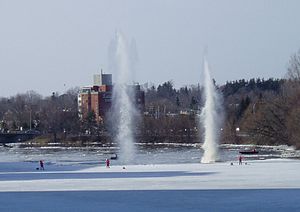This is an old revision of this page, as edited by SmackBot (talk | contribs) at 23:05, 4 July 2009 (Date maintenance tags and general fixes). The present address (URL) is a permanent link to this revision, which may differ significantly from the current revision.
Revision as of 23:05, 4 July 2009 by SmackBot (talk | contribs) (Date maintenance tags and general fixes)(diff) ← Previous revision | Latest revision (diff) | Newer revision → (diff)| This article does not cite any sources. Please help improve this article by adding citations to reliable sources. Unsourced material may be challenged and removed. Find sources: "Ice blasting" – news · newspapers · books · scholar · JSTOR (July 2009) (Learn how and when to remove this message) |
| The topic of this article may not meet Misplaced Pages's general notability guideline. Please help to demonstrate the notability of the topic by citing reliable secondary sources that are independent of the topic and provide significant coverage of it beyond a mere trivial mention. If notability cannot be shown, the article is likely to be merged, redirected, or deleted. Find sources: "Ice blasting" – news · newspapers · books · scholar · JSTOR (July 2009) (Learn how and when to remove this message) |

Ice blasting is the use of explosives to break up ice in rivers, greatly aiding navigation systems. This is done during the spring when snow is melting and river ice is breaking up. There is always a chance that the ice flows could collide creating an ice jam creating a dam and blocking the river. The river, filled with melt water, will quickly flood and often cause damage to nearby settlements. Thus in most northern areas governments quickly act to break up the ice jams before they can do much damage. This is most easily done with explosives. These explosives may be planted from the shore, or in some cases by helicopter. In the large rivers of the Siberia the Russian airforce is sometimes called in to bomb ice jams.
Some districts, where flooding is especially common, do preemptive ice blasting. The city of Ottawa, Canada, for instance, blasts the Rideau River each spring to break up the ice.
Ice blasting has a number of disadvantages. It is expensive and dangerous requiring highly skilled explosives experts. When blasting is occurring the public must be warned to keep their distance. The blasting has negative environmental consequences. Fish and other river creatures are inevitably killed and the river bottom is scarred.